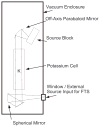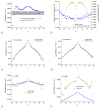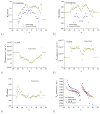Multispectrum analysis of the oxygen A-band
- PMID: 27840454
- PMCID: PMC5103325
- DOI: 10.1016/j.jqsrt.2016.03.037
Multispectrum analysis of the oxygen A-band
Abstract
Retrievals of atmospheric composition from near-infrared measurements require measurements of airmass to better than the desired precision of the composition. The oxygen bands are obvious choices to quantify airmass since the mixing ratio of oxygen is fixed over the full range of atmospheric conditions. The OCO-2 mission is currently retrieving carbon dioxide concentration using the oxygen A-band for airmass normalization. The 0.25% accuracy desired for the carbon dioxide concentration has pushed the required state-of-the-art for oxygen spectroscopy. To measure O2 A-band cross-sections with such accuracy through the full range of atmospheric pressure requires a sophisticated line-shape model (Rautian or Speed-Dependent Voigt) with line mixing (LM) and collision induced absorption (CIA). Models of each of these phenomena exist, however, this work presents an integrated self-consistent model developed to ensure the best accuracy. It is also important to consider multiple sources of spectroscopic data for such a study in order to improve the dynamic range of the model and to minimize effects of instrumentation and associated systematic errors. The techniques of Fourier Transform Spectroscopy (FTS) and Cavity Ring-Down Spectroscopy (CRDS) allow complimentary information for such an analysis. We utilize multispectrum fitting software to generate a comprehensive new database with improved accuracy based on these datasets. The extensive information will be made available as a multi-dimensional cross-section (ABSCO) table and the parameterization will be offered for inclusion in the HITRANonline database.
Keywords: atmospheric absorption; collision-induced absorption; multispectrum fitting; oxygen; spectral lineshapes.
Figures












References
-
- Rothman LS, Barbe A, Benner DC, Brown LR, Camy-Peyret C, Carleer MR, et al. The HITRAN Molecular Spectroscopic Database: Edition Of 2000 Including Updates Through 2001. J Quant Spectrosc Radiat Transfer. 2003;82(1):5–44.
-
- Rothman LS, Jacquemart D, Barbe A, Benner DC, Birk M, Brown LR, et al. The HITRAN 2004 Molecular Spectroscopic Database. J Quant Spectrosc Radiat Transfer. 2005;96(2):139–204.
-
- Rothman LS, Gordon IE, Barbe A, Benner DC, Bernath PE, Birk M, et al. The HITRAN 2008 Molecular Spectroscopic Database. J Quant Spectrosc Radiat Transfer. 2009;110(9–10):533–572.
-
- Eldering A, Boland S, Solish B, Crisp D, Kahn P, Gunson M. High Precision Atmospheric CO2 Measurements From Space: The Design And Implementation Of OCO-2. Aerospace Conference, 2012 IEEE. 2012:1–10.
-
- O’Dell C, Connor B, Bösch H, O’Brien D, Frankenberg C, Castano R, et al. The ACOS CO2 Retrieval Algorithm Part 1: Description and Validation Against Synthetic Observations. Atmos Meas Tech Discuss. 2011;4(5):6097–6158. doi: 10.5194/amtd-4-6097-2011. - DOI
Publication types
Grants and funding
LinkOut - more resources
Full Text Sources
Other Literature Sources
